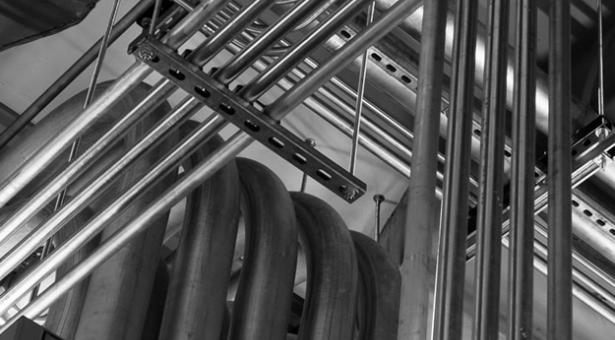

Secondary Coolant Loop Simulation

The Secondary Coolant loop uses thermal energy from the primary loop to create steam. This steam is used to drive a generation turbine, producing power.
Once past the turbine, the steam is passed through a Radiant Heat Sink Array (RHSA) to cool and condense it back to water. This water is pumped back into the Thermal Exchanger.
The secondary coolant loop is a closed loop. A pressure gradient is maintained between the output side of the turbine (including the condenser stage) and the input side of the turbine (including the thermal exchange) to increase generator efficiency.
Thermal Exchanger
In the thermal exchanger coolant from the secondary coolant loop flows over primary coolant loop pipes. The thermal gradient between the two loops causes a transfer of thermal energy from the primary loop to the secondary loop.
The flow rate of the secondary loop affects the rate of thermal transfer. A lower flow rate allows more heat to be absorbed, but as the flow rate is maintained for the whole loop there are downstream impacts which negate transfer gains for flow rates beyond nominal.
The thermal flux from the surface of the exchanger’s primary interface (a two-dimensional surface) dissipates into the volume of the secondary coolant. The higher the flow rate, the more volume of secondary coolant for dissipation, reducing thermal flux.
Function
The amount of energy transferred from the primary interface to the secondary loop coolant is described by the function:
Where F is the thermal flux from the primary exchange (in watts), V is the volume of secondary coolant in the exchanger (Vvar is variance from nominal (nominal being the capacity of the exchanger), Rvar is the variance from nominal of the flow rate of the secondary coolant (nominal being 1) and c is a flow constant (0.6)
The output of the function is in watts. It is converted to degrees centigrade by multiplying by 0.03159
Generator Stage
The generator is a sub-system of the secondary coolant loop and is documented separately for clarity.
Radiant Heat Sink Array (RHSA)
The steam from the generator stage will be condensed back to water by the Radiant Heat Sink Array (RHSA) so it can be fed back to the thermal exchanger. The lower the temperature of the secondary coolant when it enters the exchanger, the greater the delta and the more efficient the exchanger becomes.
The exhaust steam enters the RHSA via an input manifold for distribution to the four Isothermal Radiators (ISOs) making up the RHSA. The manifold allows the selection of which ISOs are operational, typically to avoid the use of ISOs that are facing the heat of a nearby star when the vessel is operating in a stellar system. The ISOs are located either side of the vessel so that one pair can always be facing away from an environmental heat source.
The condensing process increases in efficiency the more ISOs are operational.
A lower flow rate reduces the efficiency of the ISOs, which are designed to minimise IR radiation which can be detected by threat vessels. To this end the ISOs rely on thermal convection processes (depsite the name of the array) which is more efficient at greater fluid flow rates.
The impact of low flow rates increases when the number of ISOs in use decreases.
Thermal Transfer Rate
Where ΔX is the delta between the secondary coolant loop temperature and the environmental temperature the RHSA is facing, s is the surface area of the RHSA and t is the transfer co-efficient (a constant of 0.015).
Output Temperature
where ΔX is the ISOs temperature delta (see above), T is the transfer rate (see above), f is the flow rate through the ISOs (this is the loop flow rate F divided by the number of ISOs in use), m is a modifier (0.39) and c is a flow constant (0.58).
The output of the RHSAs flows through another manifold to a single feed back into the thermal exchanger (via a pressure pump). The output of the RHSAs is averaged according to the flow rate through each (an RHSA with a higher flow rate will have more impact on overall output temperature).
Each RHSA is capable of taking a flow rate of up to 1 (ie the entire secondary coolant loop can be routed through a single RHSA).








